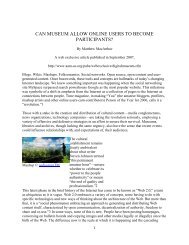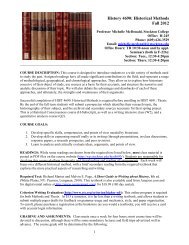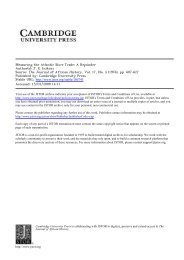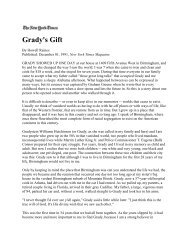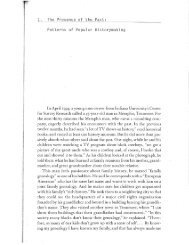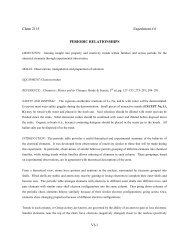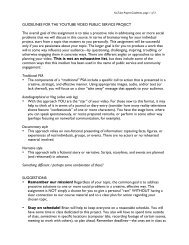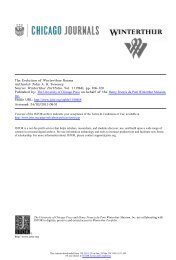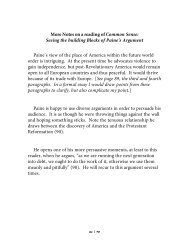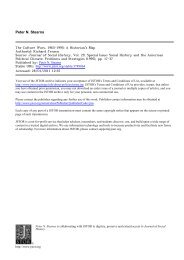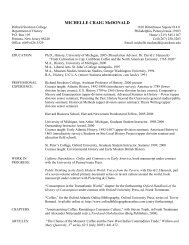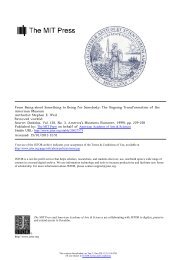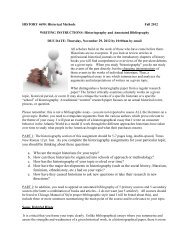What Is the Object of This Exercise? A Meandering Exploration of ...
What Is the Object of This Exercise? A Meandering Exploration of ...
What Is the Object of This Exercise? A Meandering Exploration of ...
You also want an ePaper? Increase the reach of your titles
YUMPU automatically turns print PDFs into web optimized ePapers that Google loves.
The Many Meanings <strong>of</strong> <strong>Object</strong>s in Museums 171<br />
cases one could say that <strong>the</strong> signature, ra<strong>the</strong>r than <strong>the</strong> image,<br />
becomes <strong>the</strong> object. Photographs printed by <strong>the</strong> photographer<br />
may be considered more real than those using <strong>the</strong> same nega<br />
tive but printed by<br />
someone else. With <strong>the</strong> invention <strong>of</strong> digital<br />
technology, many identical images<br />
can be reproduced<br />
at will<br />
without recourse to any negative at all. So <strong>the</strong> notion <strong>of</strong> au<strong>the</strong>n<br />
ticity (meaning singularity<br />
or<br />
uniqueness) becomes problematic<br />
as<br />
images indistinguishable from those in museums are<br />
easily<br />
available outside <strong>the</strong> museum. It is <strong>the</strong> artist's sensibility that<br />
produced <strong>the</strong> image. It is <strong>the</strong> image itself, <strong>the</strong>refore, that is <strong>the</strong><br />
object.<br />
IS THE STORY THE OBJECT?<br />
Of <strong>the</strong> utilitarian objects <strong>of</strong> <strong>the</strong> twentieth century, most are<br />
manufactured in<br />
huge quantities and <strong>the</strong>refore could be termed<br />
"examples." Which <strong>of</strong> <strong>the</strong>se objects<br />
to collect <strong>of</strong>ten <strong>the</strong>n de<br />
pends<br />
not upon <strong>the</strong> object itself but on an associated story that<br />
may render one <strong>of</strong> <strong>the</strong>m unique<br />
or<br />
important.<br />
The objects present in <strong>the</strong> death camps <strong>of</strong> <strong>the</strong> Holocaust<br />
were, in <strong>the</strong> main, created for use elsewhere. There is<br />
nothing<br />
unique in <strong>the</strong> physicality <strong>of</strong> a bowl that comes from Auschwitz<br />
Birkenau. These bowls could have been purchased<br />
in<br />
shops that<br />
sold cheap tableware all over Germany at <strong>the</strong> time. However,<br />
when <strong>the</strong> visitor reads <strong>the</strong> label that says <strong>the</strong> bowl comes from<br />
Auschwitz, <strong>the</strong> viewer, knowing something about <strong>the</strong> Holo<br />
caust, transfers meaning<br />
to <strong>the</strong> object. Since <strong>the</strong>re is nothing<br />
aside from <strong>the</strong> label that makes <strong>the</strong> bowl distinctive, it is not <strong>the</strong><br />
bowl itself but its associated history that forms importance for<br />
<strong>the</strong> visitor.<br />
DOES THE CULTURAL CONTEXT MAKE THE OBJECT?<br />
As Foucault and many o<strong>the</strong>rs have written, objects lose <strong>the</strong>ir<br />
meaning without <strong>the</strong> viewer's knowledge and acceptance <strong>of</strong><br />
underlying aes<strong>the</strong>tic or cultural values. Without such knowl<br />
edge,<br />
an<br />
object's reification even within its own<br />
society cannot<br />
be understood. Often <strong>the</strong> discomfort <strong>of</strong> novice visitors to art<br />
museums has to do with <strong>the</strong>ir lack <strong>of</strong> understanding <strong>of</strong> <strong>the</strong><br />
<strong>This</strong> content downloaded on Tue, 15 Jan 2013 12:26:43 PM<br />
All use subject to JSTOR Terms and Conditions



